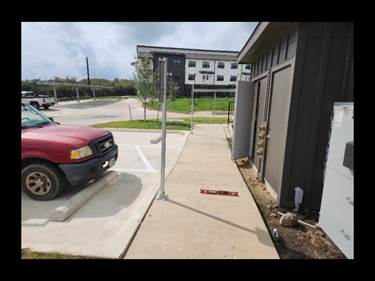When Vehicles Invade the Sidewalk: Understanding Clear Width Requirements and Overhang Hazards
Authored by Robert Green, Director of Accessibility Services at ACI
In the world of accessibility compliance, a few inches can make all the difference. One of the most common—and often overlooked—barriers to accessible design is the encroachment of parked vehicles, particularly overhangs, into pedestrian routes. While a sidewalk may appear compliant based on its poured dimensions, actual usability can be compromised once vehicles are parked, especially head-in.
This post explores clear width requirements, the impact of vehicle overhangs, and why good intentions on paper can result in noncompliance once a site is occupied.
What Is Clear Width?
Under both the 2010 ADA Standards for Accessible Design and the Texas Accessibility Standards (TAS), the minimum clear width of an accessible route is 36 inches (915 mm), as established in Section 403.5.1 of both standards. This minimum must be maintained continuously, excluding allowable reductions under the exception to 403.5.1, which permits a reduction to 32 inches (815 mm) for a maximum length of 24 inches (610 mm), such as when passing a door jamb or a short, fixed obstruction.
However, where an accessible route also serves as a general pedestrian walkway—especially in multifamily or mixed-use developments—the layout must also anticipate and prevent routine encroachments by vehicle overhangs, landscaping, or site furnishings.
Where passing spaces are required (typically every 200 feet where the route is less than 60 inches wide), Section 403.5.3 requires a passing space at least 60 inches by 60 inches (1525 mm x 1525 mm).
A sidewalk designed with a gravel buffer appears compliant until a parked vehicle’s trailer hitch reduces the clear width to just 24 inches—well below ADA and TAS requirements.
The Real-World Problem: Overhang Encroachment
The images included here illustrate sidewalks that appear compliant based on their constructed width yet are rendered unusable when parked vehicles encroach into the pedestrian path. In one example, a trailer hitch reduces the sidewalk to just 24 inches of clearance. In another, a flatbed truck has been backed into a head-in space, with the bed extending far enough to completely block pedestrian access. This is a dramatic but instructive example—not of a design flaw, but of how actual parking behavior and vehicle type can create unanticipated barriers.
A trailer hitch from a parked truck encroaches into the sidewalk, reducing the clear width and creating a barrier for pedestrians with disabilities.
A flatbed truck backed into a space entirely blocks the sidewalk. While designers are not required to account for commercial vehicle overhangs, this condition highlights the unpredictability of parking behavior.
While code does not require designers to anticipate commercial vehicles or flatbeds in standard parking spaces, such real-world conditions reinforce the importance of designing for at least a 24-inch overhang buffer. Sidewalks built to the 60-inch minimum are compliant but may still be impacted when vehicles pull forward—or in rare cases, back in—and intrude upon the pedestrian route.
These conditions are especially concerning for individuals using wheelchairs, scooters, walkers, or strollers who may be forced into vehicular traffic or otherwise unsafe conditions.
Why Vehicle Overhangs Matter
The typical passenger vehicle can extend 24 to 30 inches past the front wheels, and trucks or SUVs with towing hitches or cargo racks can protrude even more. In the absence of a physical deterrent (e.g., wheel stops or landscaping), many drivers will pull all the way forward, causing their vehicle to invade the sidewalk.
This behavior reduces the available clear width and can bring the sidewalk out of compliance with Section 403.5.1. While the exception to 403.5.1 allows for a temporary reduction in width due to fixed obstructions, vehicle overhangs are not fixed or permanent and therefore do not qualify.
Additionally, Section 502.7 of both the TAS and ADA requires that access aisles for accessible parking spaces be located so they are not obstructed by parked vehicles. While this section does not address truck overhangs directly, it reinforces the general principle that sidewalks and accessible routes must remain clear of vehicular encroachment.
Clarifying the Role of Sidewalk Width
A sidewalk built to 60 inches wide is considered sufficient to meet minimum accessibility requirements and allows for passing space without requiring periodic widened areas. That said, designers may wish to go beyond this minimum in locations where frequent truck use or trailer hitches are likely.
Designing for an assumed 24-inch vehicle overhang is a common risk mitigation approach. While not required, incorporating a buffer zone between parking spaces and sidewalks can help ensure the full clear width remains usable.
Relevant Standards and References
· TAS / ADA 403.5.1: Requires 36 inches minimum clear width along accessible routes.
· TAS / ADA 403.5.1, Exception: Allows reduction to 32 inches for up to 24 inches in length, only for fixed obstructions.
· TAS / ADA 403.5.3: Requires passing space of 60 inches at intervals of 200 feet where the accessible route is less than 60 inches wide.
· TAS / ADA 502.7: Requires that access aisles be located to prevent obstruction by parked vehicles.
Mitigation Strategies and Best Practices
To prevent vehicle overhangs and ensure accessibility, consider these strategies:
1. Install Wheel Stops: Use concrete wheel stops to prevent vehicle overhang from encroaching into the accessible route.
2. Add Landscaping Buffers: A gravel strip, planting bed, or curb detail between parking and walkways creates a natural barrier to encroachment.
3. Widen the Sidewalk When Feasible: While not required, sidewalks wider than 60 inches may help mitigate overhang impact in areas with expected truck traffic.
4. Use Parallel Parking Where Appropriate: Eliminates forward overhangs altogether.
5. Conduct On-Site Inspections Post-Occupancy: Verify that as-built conditions and user behavior still meet accessibility goals.
A sidewalk with wheel stops installed to prevent vehicle overhangs, ensuring the clear width remains accessible for all users.
Real-World Risk: Compliance vs. Usability
The question isn’t just whether the sidewalk meets code at occupancy — it’s whether it functions as intended once residents, guests, and commercial vehicles begin using the site. The gap between design and daily use is where accessibility barriers emerge—and where plaintiff-side testers often identify ADA/FHA violations.
ACI’s Approach
At ACI, our team of registered accessibility specialists prioritize both compliance and real-world usability. Our team has reviewed thousands of projects where technically compliant sidewalks failed due to predictable site conditions like truck overhangs. We work with developers, architects, and attorneys to evaluate and mitigate these issues early, on paper and in the field.
Conclusion
Sidewalks meeting the 60-inch minimum are considered compliant, but actual use conditions may demand more thoughtful design. While not required to anticipate commercial vehicle encroachment in every case, designers should account for standard passenger vehicle behavior and consider a 24-inch overhang buffer in layout decisions.
Accessibility isn’t just about minimums—it’s about outcomes.
ACI provides nationwide accessibility consulting for ADA, Fair Housing, and TAS compliance.
Contact us to schedule a review or inspection, or to learn how we can help you incorporate accessibility into your project—on paper and on site.
Disclaimer: This post is for informational purposes only and does not constitute legal or regulatory advice. Code interpretations may vary by jurisdiction and project. Always consult a Registered Accessibility Specialist (RAS), certified code official, or legal counsel familiar with the applicable standards in your area before making design or compliance decisions.




